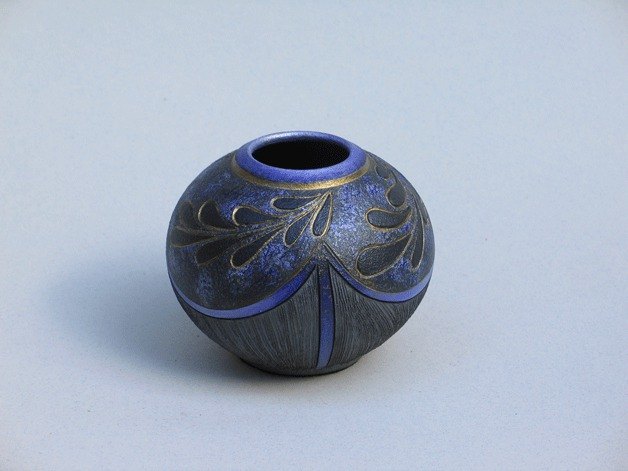To throw 26 pots, inspired by words beginning with each letter of the alphabet, is harder than it looks.
That was the challenge potter Joan Govedare gave herself when she set out to create a new series of work.
“Letters from a Potter, New Raku Pottery” by Govedare will open Friday, Sept. 3 at the Rob Schouten Gallery in Greenbank.
The longtime Whidbey Island artist has been creating raku-fired vessels for more than 30 years, adorning them with the fine etchings of the night sky, precise hand-painted renditions of constellations inspired by her astronomer father.
But Govedare’s dad also taught her about words and the love she had for him and the rest of her family — they were five altogether — was the impetus behind her decision to use language as a muse. Each pot represents one five-letter word for each letter of the alphabet in creating her newest collection.
“My dad was an English teacher, and I’ve always loved words,” Govedare said.
“It makes a nice focal point, and it stretched me out as an artist. It’s a challenge that I might not have taken otherwise.”
All 26 words are inscribed in the Braille alphabet, with each letter carved into the top lip of the bowl. The words were selected based on their meaning and the artist’s connection to them, or simply her enjoyment of them.
“‘Blind’ was the most tricky and time consuming,” she said. ‘Naked’ was like cheating.”
Govedare explained that creating the tiny little balls of Braille that appear all over the “Blind” pot was the most time consuming and required a precise and steady hand. “Naked” required her only to throw the pot and trim it, not her usual process, considering her body of work that features detailed etchings and handpainted drawings.
“Xebec” was the most personally challenging, she said. A xebec is a three-masted Mediterranean sailing ship and reminds her of her recently deceased and beloved British uncle, who loved boats.
“On the front of the raku-fired panel, I took a pin and drew a ship, which was very difficult for me,” she said.
She had to create her own tiny paintbrush made with four meager bristles to paint the pot.
“It was very hairy, but I did it. Hey, there are lots of Third World artisans who do things like that all the time,” Govedare said.
“It was challenging, but I’m very pleased with the piece. I’m sure there will be people who know my work who will say, ‘Wow, she’s never done anything like that before.’ So that was great for me to do it,” she added.
Some other words the artist used: venal, capable of being bought or obtained for money; penta, containing five; oread, any of the nymphs of mountains and hills in Greek mythology; and round, meaning plump, shapely, brought to completion or perfection — the sort of word that makes sense if one’s a potter.
“Tepee was like scratching an itch that has been going on for 40 years,” she said, noting the deep connection to the American Indian world she’s had in her heart from a young age.
Some of the pots came easily, it seems, such as the pot called “Knead,” which Govedare said was simply pure fun, while “Elder” came to her in a dream.
“I woke up and remembered three figures standing next to each other,” she recalled.
“Then the word flashed in my mind, and I grabbed a piece of paper and drew the pot. That’s the only one that happened that way,” she said, sounding slightly miffed that some of the others hadn’t.
Govedare explained how other pots and their words came to her the way one might tell a therapist things about a relationship that only can be understood behind closed doors, in quiet concentration. Her demeanor when she speaks of her work is passionately personal.
“‘Drape’ was necessary, ‘Quilt’ was a pain that was worth it, and ‘Round’ and ‘Sharp’ had to be next to each other,” Govedare said.
“The rest were coming- home parties, as I revisited favorite themes with new colors and shapes.”
In the end, the whole shebang was a long labor of love which she sends fondly out into the world.
The pieces are priced reasonably from $95 to $425, considering the eight months or so spent creating them, and the passion and intellect with which they were made.
But she wants them to end up in people’s homes, the artist said. One lucky collector could have the entire collection for $4,500 if he or she arrived to shop early enough.
But in the end, Govedare’s artistic muscle has been buffed by the experience. She’s like a prizefighter who’s won another Golden Glove championship, challenging the muse and coming out on top. After she had finished the series, she said she thought, “Wow, that’s a body of work, I was really holding that.”
Now she will don some different gloves and take a month off from the studio to work in the garden, she said.
Govedare will share the gallery with the work of painter Anne Belov.
An opening night reception will be from 5 to 8 p.m. during “First Fridays at the Farm,” with light refreshments and live music by Trio Nouveau. The show will run through Sept. 29. Rob Schouten Gallery is at Greenbank Farm.


